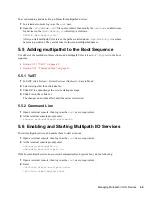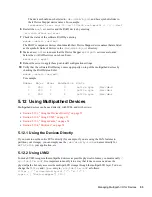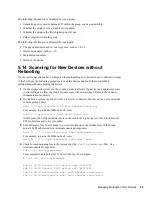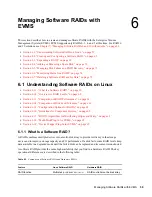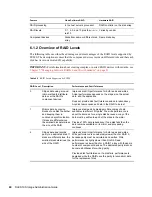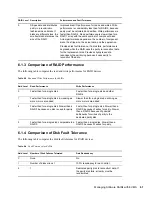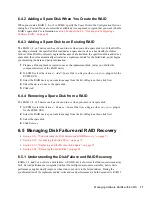
Managing Software RAIDs with EVMS
63
no
vd
ocx
(e
n)
6 Ap
ril 20
07
You can combine up to 28 component devices to create the RAID array. The
md
RAID device you
create can be up to the maximum device size supported by the file system you plan to use. For
information about file system limits for SUSE
®
Linux Enterprise Server 10, see “Large File System
Support” in the
SUSE Linux Enterprise Server 10 Installation and Administration Guide.
(http://
www.novell.com/documentation/sles10)
.
In general, each storage object included in the RAID should be from a different physical disk to
maximize I/O performance and to achieve disk fault tolerance where supported by the RAID level
you use. In addition, they should be of the same type (disks, segments, or regions).
Using component devices of differing speeds might introduce a bottleneck during periods of
demanding I/O. The best performance can be achieved by using the same brand and models of disks
and controllers in your hardware solution. If they are different, you should try to match disks and
controllers with similar technologies, performance, and capacity. Use a low number of drives on
each controller to maximize throughput.
IMPORTANT:
As with any hardware solution, using the same brand and model introduces the risk
of concurrent failures over the life of the product, so plan maintenance accordingly.
The following table provides recommendations for the minimum and maximum number of storage
objects to use when creating a software RAID:
Table 6-6
Recommended Number of Storage Objects to Use in the Software RAID
Connection fault tolerance can be achieved by having multiple connection paths to each storage
object in the RAID. For more information about configuring multipath I/O support before
configuring a software RAID, see
Chapter 5, “Managing Multipath I/O for Devices,” on page 43
.
6.1.7 RAID 5 Algorithms for Distributing Stripes and Parity
RAID 5 uses an algorithm to determine the layout of stripes and parity. The following table
describes the algorithms.
RAID Type
Minimum Number of
Storage Objects
Recommended
Maximum Number of
Storage Objects
RAID 0 (striping)
2
8
RAID 1 (mirroring)
2
4
RAID 4 (striping with dedicated parity)
3
8
RAID 5 (striping with distributed parity)
3
8
Summary of Contents for LINUX ENTERPRISE SERVER 10 - STORAGE ADMINISTRATION GUIDE 7-2007
Page 4: ...novdocx en 6 April 2007...
Page 30: ...30 SLES 10 Storage Administration Guide novdocx en 6 April 2007...
Page 42: ...42 SLES 10 Storage Administration Guide novdocx en 6 April 2007...
Page 58: ...58 SLES 10 Storage Administration Guide novdocx en 6 April 2007...
Page 90: ...90 SLES 10 Storage Administration Guide novdocx en 6 April 2007...
Page 100: ...100 SLES 10 Storage Administration Guide novdocx en 6 April 2007...
Page 106: ...106 SLES 10 Storage Administration Guide novdocx en 6 April 2007...

